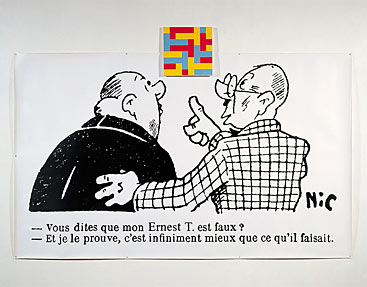
Born in 1943 in Mons (BE)
Lives and works in Paris (FR)

1989
Photograph, acrylic on canvas
120 x 197 cm
Toile : 28 x 28 cm
Year of Purchase: 1992
As the temporary pseudonym of an artist striving constantly to blur his image, escape all actual visibility, appropriate personalities and imaginary signatures, so as to parody art with art and review the mechanics of legitimizing the artistic personality, Ernest T. is just a sign, a logo, a virtual name with nothing tangible to it, which appeared in 1983, and then gradually faded out from the art scene in the 1990s onward. This artist’s flight from his figure ‘represented’ and categorized, by words, dates and images (a refusal to give his name, reveal his biography, appear on his own in photographs), helps him to ridicule, with impunity, that other self, turn it into the subject of a critical analysis, a strategy which denounces at the same time as it announces the petty-mindedness of the art market. Initiated by Andy Warhol, this subversive conceptual approach, typical of the postmodern state of ‘doubt’ in search of critical meaning, is based on the systematic diverting of reference, in the proclaimed authenticity of art, not exempt from the temptations of the consumer society.
At the outset, Ernest T. put his name to advertising inserts in magazines: minor manifestoes, tracts, pamphlets, wanted notices, etiquette manuals, prophetic formulae in the style of social satire. Subsequently he appropriated a style, an abstract geometric banner made of dovetailed blue, red and yellow ‘T’s, which one finds affixed to old enlarged cartoons. Inserted into these caricatural playlets, these ‘real’ paintings become modern narcissists, ‘objects of speculation and nothing else’ (Ernest T.), coveted for their signature. But by making a distinction between painting and drawing, the progenitor of Ernest T. created a system of connections, a reflection between what is said and what is shown – this particular Ernest T. is truly atypical – which questions the value of the original, the true and the false. He uses the irony of linguistic games both literally and figuratively as an artistic act which, in order to be legitimate, calls for a perverse self-criticism on the part of the players of the various ‘art worlds’. Who is the impostor, the art market, or Ernest T.?
Maïté Vissault